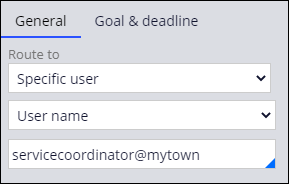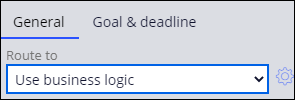
Routing work to users
2 Tasks
10 mins
Scenario
Note: The framework of this challenge uses the view-based Constellation architecture of Pega Platform. To practice this challenge on the traditional UI-based architecture Theme Cosmos, see the Routing work to users version 8.7 challenge.
Specific members of the city government perform assignments on service request cases. The services coordinator identifies three assignments that must be routed during case processing: Schedule repair, Review repair, and Perform repair. The Schedule repair and Review repair assignments are routed to the municipal services coordinator. The Perform repair assignment is routed to the appropriate operator based on the department responsible for the reported issue.
The services coordinator provides the following table listing the conditions that determine how to route the Perform repair assignment:
| Route to | Value | Field | Comparator | Value |
|---|---|---|---|---|
| Operator | parksmgr@mytown | Department | is equal to | "Parks and Recreation" |
| Operator | dpwmgr@mytown | Department | is equal to | "Public Works" |
| Operator | trafficmgr@mytown | Department | is equal to | "Traffic Management" |
The following table provides the credentials you need to complete the challenge.
| Role | User name | Password |
|---|---|---|
| Application Developer | author@mytown | pega123! |
Note: Your practice environment may support the completion of multiple challenges. As a result, the configuration shown in the challenge walkthrough may not match your environment exactly.
Challenge Walkthrough
Detailed Tasks
1 Route the Schedule repair and Review repair steps to a specified user
- In the Pega instance for the challenge, enter the following credentials:
- In the User name field, enter author@mytown.
- In the Password field, enter pega123!.
- Click Case types > Service Request to display the case life cycle.
- Click the Schedule repair step to display the configuration pane on the right.
- On the General tab of the configuration pane, in the Route to drop-down, select Specific user.
- In the drop-down under Specific user, verify that the value defaults to User name.
- In the field under User name, enter or select servicecoordinator@mytown to route the Schedule repair task to the specific user.
Note: Pressing the Down arrow in this field reveals the list of users available to work in the application.
- Click the Review repair step to display the configuration pane on the right.
- On the General tab, verify that the Route to drop-down defaults to Specific user.
- In the drop-down under Specific user, verify that the value defaults to User name.
- In the field under User name, enter or select servicecoordinator@mytown to route the Review repair task to the specific user.
2 Route the Perform repair step using business logic
- Click the Perform repair step to display the configuration pane on the right.
- On the General tab of the configuration pane, in the Route to drop-down, select Use business logic.
- To the right of the Route to drop-down, click the Gear icon to display the Business logic window.
- In the Business logic window, to the right of the 1 label, verify that the Route to drop-down is set to Operator.
Note: The Route to drop-down defaults to Operator. For this exercise, verify that the default remains the same for each condition.
- In the Value field, enter or select parksmgr@mytown as the operator.
- In the second row, in the Select drop-down, select Fields > Request > Department.
- In the Comparator drop-down, verify that the value defaults to is equal to.
Note: For this exercise, the business logic remains as the default is equal to condition.
- In the empty field to the right of the Comparator drop-down, enter Parks and Recreation to set the value to compare in the condition. The first condition is now set to route to parksmgr@mytown when the condition is true.
Note: You can include quotation marks when you enter the condition value; otherwise, the system adds quotation marks automatically. For example, if you enter Parks and Recreation, the system adds the quotation marks, as shown in the following image:Tip: You can also click the Gear icon to choose from a list of Existing values for the Department field.
- Click Add Condition to set the conditions for the dpwmgr@mytown and trafficmgr@mytown operators.
- For each condition-operator pairing, repeat steps 4-8 to route the Perform repair assignment to the appropriate operator using business logic:
Route to Value Field Comparator Value Operator dpwmgr@mytown Department is equal to "Public Works" Operator trafficmgr@mytown Department is equal to "Traffic Management" - Under Add condition, to the right of otherwise, verify that the Route to drop-down is set to Operator.
- To the right of the Route to drop-down, in the Value field, enter or select servicecoordinator@mytown to set the operator for the otherwise condition.
- Click Submit to save the routing logic.
- Click Save.
Confirm your work
Repeat the steps in this section for each type of request to verify that the Perform Repair assignment is routed according to the following table:
| Request type | Department | Department manager | Initials |
|---|---|---|---|
| Park maintenance | Parks and Recreation | parksmgr@mytown | PM |
| Pothole | Public Works | dpwmgr@mytown | DM |
| Road debris | Public Works | dpwmgr@mytown | DM |
| Traffic signal | Traffic Management | trafficmgr@mytown | TM |
- Click Save and run to run a new case.
- In the Report problem view, select Traffic signal as the Request type.
- Click Next to advance the case.
- Click Next to advance the case past the Identify location view.
- Click Next to advance the case past the Identify submitter view.
- Click Submit to advance the case.
- Verify that the case has advanced to the Schedule repair view and is routed to the Municipal Services Coordinator, as indicated by the initials MS.
Note: Pega Platform™ indicates the user to whom a task is routed by the use of an avatar. By default, the avatar for a user consists of the initials of that user.Tip: Click the avatar to display information about the assigned user, including the name of the user.
- Click Go to open the Schedule repair view.
- Enter a Due date of tomorrow, and click Submit to advance the case.
- In the Perform repair view confirm the step is routed to the Traffic Department Manager as indicated by the initials TD.
- Click Go to open the Perform repair view.
- Click Submit to advance the case.
- In the To do section, verify that the case has advanced to the Approve repair step and is routed to the Municipal Services Coordinator, as indicated by the initials MS.
This Challenge is to practice what you learned in the following Module:
Available in the following missions:
If you are having problems with your training, please review the Pega Academy Support FAQs.
Want to help us improve this content?








